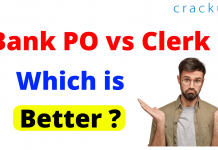Download Reasoning Questions For IBPS PO PDF
Take a free mock test for IBPS PO
Download IBPS PO Previous Papers PDF
Instructions
Direction: In each of the questions below are given four statements followed by four conclusions numbered I, II, III & IV. You have to take the given statements to be true even if they seem to be at given conclusions logically follows from the given statements disregarding commonly known facts.
Question 1: Statements:
All cups are bottles.
Some bottles are jugs.
No jug is plate.
Some plates are tables.
Conclusions:
I. Some tables are bottles.
II. Some plates are cups.
III. No table is bottle.
IV. Some jugs are cups.
a) Only I follows
b) Only II follows
c) Only III follows
d) Only IV follows
e) Only either I or III follows
Question 2: Statements:
Some chairs are handles.
All handles are pots.
All pots are mats.
Some mats are buses.
Conclusions:
I. Some buses are handles.
II. Some mats are chairs.
III. No bus is handle.
IV. Some mats are handles.
a) Only I, II and IV follow
b) Only II, III and IV follow
c) Only either I or III and II follow
d) Only either I or III and IV follow
e) Only either I or III and II and IV follow
Question 3: Statements:
All birds are horses.
All horses are tigers.
Some tigers are lions.
Some lions are monkeys.
Conclusions:
I. Some tigers are horses.
II. Some monkeys are birds.
III. Some tigers are birds.
IV. Some monkeys are horses.
a) Only I and III follow
b) Only I, II and III follow
c) Only II, III and IV follow
d) All I, II, III and IV follow
e) None of these
Instructions
In each of the following questions relationship between
different elements is shown in the statements. The statements are followed by two
Conclusions numbered I and II. Study the Conclusions based on the given
statements and select the appropriate answer.
a: if only Conclusion II is true
b: if only Conclusion I is true
c: if both the Conclusion I and Conclusion II are true
d: if either Conclusion I or Conclusion II is true
e: if neither Conclusion I nor Conclusion II is true
IBPS PO Quant Formulas & Shortcuts
Question 4: Statements :
$S \leq L \leq I = P \geq E \geq R$
L>Q
Conclusions :
I. P > S
II. I > R
a) if only Conclusion II is true
b) if only Conclusion I is true
c) if both the Conclusion I and Conclusion II are true
d) if either Conclusion I or Conclusion II is true
e) if neither Conclusion I nor Conclusion II is true
Question 5: Statements :
S<L<I=P>E>R
L>Q
Conclusions :
I. L < R
II. E > Q
a) if only Conclusion II is true
b) if only Conclusion I is true
c) if both the Conclusion I and Conclusion II are true
d) if either Conclusion I or Conclusion II is true
e) if neither Conclusion I nor Conclusion II is true
Question 6: Statements :
G>R>E=A<T<S
D < A < J
Conclusions :
I. T > D
II. R > S
a) if only Conclusion II is true
b) if only Conclusion I is true
c) if both the Conclusion I and Conclusion II are true
d) if either Conclusion I or Conclusion II is true
e) if neither Conclusion I nor Conclusion II is true
Question 7: What should come next in the following numbers sequence ?
2 2 3 2 3 4 2 3 4 5 2 3 4 5 6 2 3 4 5 6 7 2 3 4
a) 8
b) 5
c) 6
d) 2
e) None of these
Question 8: What should come next in the following letter series based on English alphabet ?
CEA IKG OQM ?
a) STW
b) WUS
c) SWU
d) UWS
e) None of these
Question 9: What should come next in the following letter series ?
PQRSTABCDEPQRSABCDEPQRSABCDPQ
a) R
b) T
c) A
d) B
e) None of these
IBPS PO Previous Papers (Download Pdf)
Question 10: What should come next in the following letter series based on English alphabet ?
CEA IKG OQM ?
a) STW
b) WUS
c) SWU
d) UWS
e) None of these
Question 11: What should come next in the following letter series ?
P Q R S T A B C D E P Q R S
A B C D E P Q R S A B C D P Q
a) R
b) T
c) A
d) B
e) None of these
Question 12: How many meaningful English words can be made with the letters DLEI using each letter only once in each word?
a) None
b) One
c) Two
d) Three
e) More than three
Question 13: Among A, B, C, D and E each having different weight, D is heavier than only A and C is lighter than B and E. Who among them is the heaviest?
a) B
b) E
c) C
d) Data inadequate
e) None of these
Question 14: Pratap corrrectly remembers that his mother’s birthday is before twenty third April but after Nineteenth April, where as his sister correctly remembers that their mother’s birthday is not on or after twenty second April. On which day in April is definitely their mother’s birthday ?
a) Twentieth
b) Twenty-first
c) Twentieth or twenty-first
d) Cannot be determined
e) None of these
Instructions
A, B, C, D, E, F, G and H are eight employees of an organization working in three departments viz. Personnel, Administration and Marketing with not more than three of them in any department. Each of them has a different choice of sports from football, cricket, volleyball, badminton, lawn tennis, basketball, hockey and table tennis not necessarily in the same order. D works in Administration and does not like either football or cricket. F works in Personnel with only A who likes table tennis. Eand H do not work in the same department as D. C likes hockey and does not work in marketing. G does not work in administration and does not like either cricket or badminton. One of those who work in administration likes football. The one who likes volleyball works in personnel. None of those who work in administration likes either badminton or lawn tennis. H does not like cricket.
Question 15: Which of the following groups of employees work in Administration department ?
a) EGH
b) AF
c) BCD
d) BGD
e) Data inadequate
Question 16: In which department does E work ?
a) Personnel
b) Marketing
c) Administration
d) Data inadequate
e) None of these
Question 17: Which of the following combinations of employee-department-favourite sport is correct?
a) E – Administration – Cricket
b) F – Personnel – Lawn Tennis
c) H – Marketing – Lawn Tennis
d) B – Administration – Table Tennis
e) None of these
Question 18: What is E’s favourite sport?
a) Cricket
b) Badminton
c) Basketball
d) Lawn Tennis
e) None of these
Question 19: What is G’s favourite sport ?
a) Cricket
b) Badminton
c) Basketball
d) Lawn Tennis
e) None of these
Instructions
Directions: Study the following information and answer the following questions: A, B, C, D, E, G, and I are seven friends who study in three different standards, namely 5th, 6th, and 7th, such that not less than two friends study in the same standard. Each friend has a different favourite subject, namely History, Civics, English, Marathi, Hindi, Maths and Economics also but not necessarily in the same order.
A likes Maths and studies in the 5th standard with only one other friend who likes Marathi. I studies with two other friends. Both the friends who study with I like languages (here languages include only Hindi, Marathi and English). D studies in the 6th standard with only one person and does not like Civics. E studies with only one friend. The one who likes History does not study in the 5th or 6th standard. E does not like languages. C does not like English, Hindi or Civics.
Question 20: Which combination represents E’s favourite subject and the standard in which he studies?
a) Civics and 7th
b) Economics and 5th
c) Civics and 6th
d) History and 7th
e) Economics and 7th
IBPS PO Important Questions PDF
Free Banking Study Material (15,000 Solved Questions
Answers & Solutions:
1) Answer (E)
The conclusions talk about a relation between tables and bottles. Let’s bring a relation between these two using the given statements.
Some bottles are jugs and no jug is a plate => some bottles can be plates or no bottle is a plate
Some plates are tables => some bottles can be plates or no bottle is a plate. — (1)
All cups are bottles and some bottles are jugs => Nothing about cups and jugs can be derived from this.
Since we cannot derive a conclusion between cups and jugs, it is not possible to derive a conclusion between cups and plates as well.
Hence option E, which says that some bottles can be plates or no bottle is a plate is the answer.
2) Answer (E)
The following are the two possibilities:


So, either I or III and II and IV follow.
3) Answer (A)
Birds is a subset of Horses, which is a subset of Tigers. So, conclusions I and III follow. But, conclusions II and IV need not follow.
4) Answer (E)
The possibility S = L = I = P = E = R cannot be ruled out. Hence, neither of the two conclusions is necessarily true.
5) Answer (E)
6) Answer (E)
$D \leq A$ and $A \leq T$, then D = A = T is a possibility. Hence, we cannot say D < T. Hence, Conclusion I does not follow.
As we cannot establish a relation between R and S, Conclusion II does not follow.
Hence, option E.
7) Answer (B)
In the given number sequence, the 2 is repeated and at nth place staring from 2 to (n+1) number is repeated.
This can also be visualised by viewing the series as:
2
2 3
2 3 4
2 3 4 5
2 3 4 5 6
2 3 4 5 6 7
Hence, the next number in series, going by this logic would be 5.
The correct option is B
8) Answer (D)
Based on the English alphabet, the above arrangement follows the following pattern :
The first alphabet in each word is
C –(+6)–> I –(+6)–> O –(+6)–> U
The second alphabet is
C –(+2)–> E
$\therefore$ U –(+2) –> W
And the third alphabet is
C –(-2)–> A
$\therefore$ U –(-2) –> S
Thus, UWS wil be the next letter in the series.
9) Answer (A)
The above series is the combination of two series i.e. :
PQRST & ABCDE
After that, last alphabet of the first series is removed => PQRS & ABCDE
Then ,the last alphabet of the second series is removed => PQRS & ABCD
After that, S should be removed => PQR & ABCD
Clearly, the next letter is R.
10) Answer (D)
Here the pattern followed is the sixth letter from the starting letter of previous word is first written. Then the second word to th e rigt i swritten and subsquently second word to th eleft is written.
We are supposed to find fourth word. The initial letter of the previous word is O. The sixth letter from O is U. Second letter to th eright of U is W and to th eleft of O is S.
Hence, then word is UWS.
Option D is correct answer.
11) Answer (A)
Here, there is repetition of series twice and then subsequent truncation.
First PQRS…series is truncated and next ABCD…is truncated.
Going by this pattern, PQRS will be truncated. However the next letter is R in the series.
Option A is correct answer.
12) Answer (C)
Only two words can be made out of DLEI
- IDLE
- LIED
13) Answer (D)
D > A and C < B , E
We don’t know the relation between A and B , B and E , B and D , D and E and A and C.
So it is impossible to answer this question without providing any of the required information.
Hence Data Inadequate
14) Answer (C)
According to Pratap, his mother’s birthday can be on 20th, 21st or 22nd of April.
According to Pratap’s sister, her mother’s birthday can be on 20th or 21st of April.
=> Their mother’s birthday can be on either 20th or 21st of April.
15) Answer (C)
According to the above table, B, C and D work in Administration department.
16) Answer (B)
Based on the information given, we can draw the table given above. Hence, E works in Marketing department.
17) Answer (E)
E works in Marketing => A is wrong
F likes Volleyball => B is wrong
H likes Badminton => C is wrong
B likes Football => D is wrong
=> None of these
18) Answer (A)
Based on the information given, we can draw the table given above. Hence, E’s favourite sport is Cricket.
19) Answer (D)
According to the table, G’s favourite sport is Lawn Tennis.
20) Answer (C)
Let us solve the question by the tabular method

A is in 5th standard and likes Maths. So tick the blanks 5th standard and Maths for A and cross the rest of the Maths column.
A studies with only one person who likes Marathi. I studies with two other friends who like languages.D studies in 6th standard with only one person and does not like civics. So tick the 6th standard blank corresponding to D and cross the civics blank for D. E studies with only one friend and doesn’t like languages. The one who likes history doesn’t study in 5th or 6th standard. D , E study with only one person. D is in 6th standard and E doesn’t like languages. The remaining are B , C , G and I. I studies with two more persons who like languages. C doesn’t like English and Hindi. So C cannot be I’s classmate and can only be A’s classmate because E doesn’t like languages, C should like Marathi . Hence tick 5th standard and Marathi for C, cross the rest of the Marathi column. Similarly E is D’s classmate because E studies with only one person and doesn’t like Marathi. So tick 6th standard for E. Finally B and G are I’s classmates, hence tick the 7th standard for B,G and I. Now that the standards are set, let’s move to the subjects. Since B and G like only the languages and Marathi is already choosen by C, they are left with only two blanks each which are English and Hindi. So cross the rest of the row for B and G. The one who likes history is not in 5th and 6th. In seventh standard B and G like only languages, hence I likes history. Mark history blank of I and cross the rest of the column. Now civics column should be left with one blank , which corresponds to E. Tick the blank corresponding to civics for E and cross the rest of the row . Finally a blank in Economics column corresponding to D is left. Mark it and cross the blanks for other subjects of D’s row.
The table should look like below after following the above steps.

Now referring to the above table we can say that option c is correct answer for the above question.










